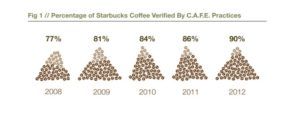Sustainability and Continuous Improvement at Starbucks
The earth is changing at a rapid pace; since 2014, Earth has recorded the three hottest years in history.1 While some choose to turn a blind eye, other corporations realize that their supply chains are in danger. Of the various natural resources subjecting those supply chains to danger, coffee bean crops are particularly vulnerable to adverse weather conditions created by climate change. Fortunately, Starbucks Coffee Company takes a proactive, creative approach to ensure sustainability for its coffee supply chain and works to improve their community at the same time.
Arabica coffee beans are the main commodity in Starbucks' supply chain and they are vulnerable for several reasons caused by the planet's increasing temperatures. The climates that currently exist will change and that change may result in land that is unsuitable for growing coffee beans. Further, we cannot view the risk of higher temperatures in isolation. Although rising temperatures have not impacted crops in Central and South America yet, the global warming induced unpredictable weather patterns and natural disasters have wreaked havoc even on well-established farms.2 As of 2011, the average hours of sunshine had decreased by at least 15%.3 This reduced the number of viable crops in the area and introduced uncertainty into the sustainability of Colombian coffee. Since many of Starbucks' suppliers are small-scale farmers, they have naturally been forced to diversify their crops and are fearful of their future in an exposed industry. Acknowledging these risks and more, Starbucks has gotten ahead of the curve.
A company known for innovation and sustainability, Starbucks has addressed the climate-related susceptibilities in its supply chain by ensuring that farmers have the resources they need while rewarding them for following sustainable practices. Starbucks approached Capitol Hill to remedy the issue, but when the company did not get the response it sought, company leaders realized their existing C.A.F.E. program would be a way to mitigate risk. Coffee and Farmer Equity standards dictate strict ethical coffee sourcing requirements and 45 percent of these requirements are relevant toward climate mitigation.4 The diagram below depicts the company's progress as of 2012 to source all beans responsibly.5

Starbucks is also working with the farming communities, setting up support centers designed to share knowledge and provide best practices in developing economies like Rwanda and Costa Rica. Most recently, the company invested $2 million into a farmer loan program that focuses on a women-led coffee cooperative in Colombia.6 This initiative aims to address the concerns of farmers who are not able to invest in more sustainable practices or the development of modern crops that will not be as susceptible to extreme weather.
Beyond the dedication to a sustainable supply chain, Starbucks is a leader in reduction of greenhouse gas emissions.7

Upon recognizing that retail stores were the worst offenders of greenhouse gas emissions and energy consumption, the company dedicated time and effort to reducing its overall footprint. Programs such a retail and commercial recycling, LED bulb replacement, reduced water consumption, and reward programs for customers who use reusable cups prove the company has adopted sustainability as a part of its business model and strategy.
Despite all the impressive strides Starbucks has made to mitigate the serious risks their supply chain is facing, they can do more. As the company continues to support farmers in other regions, it also needs to research the potential shifts in environmental capabilities as global temperatures continue to rise. New potential growing environments may surface and climates that used to be inconducive to growing Arabica beans could shift. It is vital that Starbucks continue to set an example when it comes to greenhouse gas (GHG) emissions as well. However, this can be a potential profit-driving opportunity. PepsiCo, for example, is working with its supply chain to designate products that are low GHG producers in hopes of increasing sales of those products as the average consumer looks to do his or her part in saving the environment.8 Since the company is already known to consumers as "green", they would easily generate interest by being transparent about their sustainability efforts in this way.
Looking to the future one has to wonder: how can Starbucks ensure that their efforts to make an environmental difference will be financially sustainable as well? On the other hand, should Starbucks be reinvesting financial gains from their environmental initiatives into climate change research? What are their responsibilities as a corporate leader in this space? With a strategy that has proven to be both creative and proactive, Starbucks could bring a full cup to the climate change table.
1Rebecca M. Henderson, Sophus A. Reinert, Polina Dekhtyar and Amram Migdal, "Climate Change in 2017: Implications for Business" HBS No. 9-317-032 (Boston: Harvard Business School Publishing, 2017), http://hbsp.harvard.edu, accessed November 2017.
2Suzanne Goldberg, "Starbucks concerned world coffee supply is threatened by climate change," The Guardian, October 13, 2011, [https://www.theguardian.com/business/2011/oct/13/starbucks-coffee-climate-change-threat], accessed November 2017.
3Jodie Thorpe and Shelly Fennell, "Climate Change Risks and Supply Chain Responsibility: How should companies respond when extreme weather affects small-scale producers in their supply chain?," Oxfam Policy and Practice: Private Sector Volume 9, no. 1 (2012): 39-62, ABI/INFORM via ProQuest, accessed November 2017.
4 Jodie Thorpe and Shelly Fennell, "Climate Change Risks and Supply Chain Responsibility: How should companies respond when extreme weather affects small-scale producers in their supply chain?," Oxfam Policy and Practice: Private Sector Volume 9, no. 1 (2012): 39-62, ABI/INFORM via ProQuest, accessed November 2017.
5C.A.F.E. Practices Results Assesment, 2011-2012 Annual Report, p. 4, [https://www.conservation.org/publications/Documents/2011_2012_Starbucks_CAFE_Practices_Results_Assessment.pdf], accessed November 2017.
6"Starbucks Invests in Next Generation of Colombian Coffee Farmers," ENP Newswire, July 11, 2017, https://global-factiva-com.prd1.ezproxy-prod.hbs.edu/ha/default.aspx#./!?&_suid=151061330490603209099102045154, accessed November 2017.
7Starbucks, "Climate Change," https://www.starbucks.com/responsibility/environment/climate-change, accessed November 2017.
8 Chonnikarn (Fern) Jira, Michael W. Toffel, "Engaging Supply Chains in Climate Change," Manufacturing & Service Operations Management Articles in Advance (2013): 1, accessed November 2017.
Source: https://d3.harvard.edu/platform-rctom/submission/starbucks-loving-the-planet-a-latte/
0 Response to "Sustainability and Continuous Improvement at Starbucks"
Post a Comment